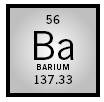Barium

MELTING POINT:
729°C
BOILING POINT
: 1,640°C
DENSITY
: 3.51 g/cm
3
MOST COMMON IONS
: Ba
2+
The fifty-sixth element in the Periodic Table, barium has been known in various mineral forms since the 1600s. However, it was not until the 1770s that Carl W. Scheele and J. G. Gahn independently began separating barium compounds from other components of various minerals, isolating barium oxide (BaO) and barium sulfide (BaSO 4 ). The latter compound was isolated from the heavy feldspar and eventually named barite, from the Greek word barys , meaning "heavy." It was not until 1808 that elemental barium was isolated by Sir Humphry Davy, using his famous electrolysis system.
In its elemental form, barium is a relatively soft, silvery-white metal . As a highly reactive member of the alkaline-earth family, metallic barium will oxidize readily in water to form barium hydroxide, evolving hydrogen gas. It will also react readily and vigorously with oxygen in air to form BaO. As with other alkaline-earth elements, barium's most common oxidation state is +2.
As the fourteenth most abundant element in Earth's crust, barium is the most common of all elements with an atomic number greater than 26 (iron). Barium and its compounds are used in a variety of ways, including in electronics, fireworks (where barium burns with its well-known yellow-green flame), paint pigments, and insecticides. Although barium compounds are highly toxic, doctors sometimes have patients ingest a special barium sulfate solution when it is necessary to x-ray their digestive tracts. The BaSO 4 is insoluble enough that it is not absorbed and so passes through the body without causing harm. In the process, the BaSO 4 can deflect X rays, thus making it possible to clearly image the soft tissue of the digestive tract.
SEE ALSO Alkaline Earth Metals ; Davy, Humphry ; Scheele, Carl .
David A. Dobberpuhl
Bibliography
Heiserman, David L. (1992). Exploring Chemical Elements and Their Compounds. Blue Ridge Summit, PA: Tab Books.
Krebs, Robert E. (1998). The History and Use of Our Earth's Chemical Elements: A Reference Guide. Westport, CT: Greenwood Press.
Comment about this article, ask questions, or add new information about this topic: